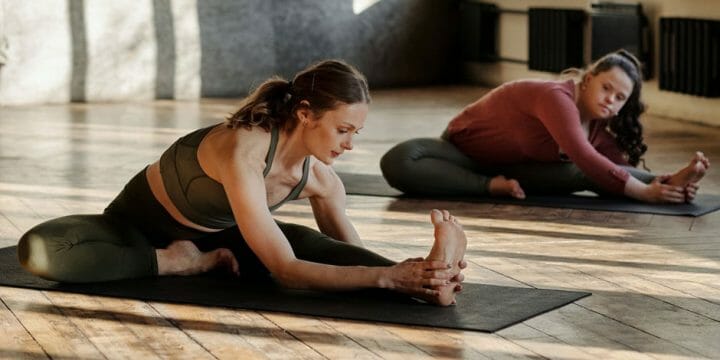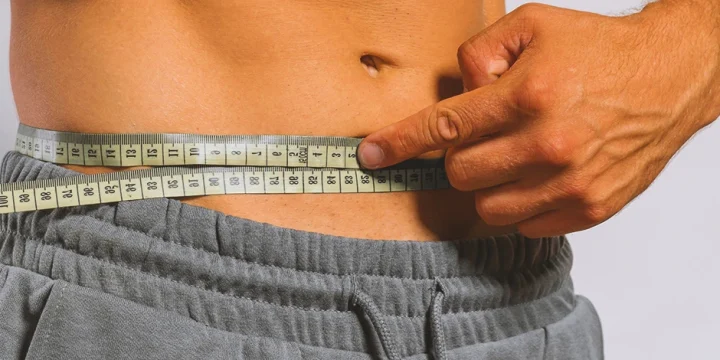Although achieving the splits can be challenging, you may add some stretches to your routine to prepare your body for full splits and benefit from their advantages.
After several months of research, I’ve put together my ten favorite stretches that will aid you in mastering your first split.
As a personal trainer, I understand that the timeframe for clients to accomplish the splits varies based on their current level of flexibility and fitness.
However, you will experience deep stretching of commonly tight areas by consistently practicing these stretches, ultimately enabling you to perform splits easily.
Quick Summary
- The best stretches for splits include the pike stretch, pyramid pose, half split, lizard lunge, low lunge quad stretch, Malasana squat, pigeon pose, butterfly pose, and frog.
- These stretches target key muscle groups such as the hamstrings, hip flexors, and glutes, which are essential for performing splits.
- According to the National Institute of Health, all forms of stretching are proven effective in increasing the range of motion, which is crucial for achieving splits.
- In my view, regularly practicing these stretches not only aids in achieving splits but also offers benefits like improved posture, increased blood flow, and stress reduction, making them a valuable addition to any fitness regimen.
10 Top Stretches for Splits

1. Seated Pike Stretch
How to perform this exercise:
- Sit on a mat with both legs straight and together in front of you.
- Place your hands behind your hips for support.
- Shift your hip crease backward while bringing your rib cage forward.
- Reach your arms forward, aiming to touch your toes or get as close as possible.
- Hold the stretch for fifteen to thirty seconds.
2. Pyramid Pose
How to perform this exercise
- Position one foot in front and the other at the back of your mat, creating a pyramid shape with your legs. Make sure that all your toes are pointing forward.
- Inhale as you raise your arms towards the ceiling.
- Exhale as you fold forward, maintaining a straight back.
- Rest your hands on either side of your front foot.
- Allow your chest to rest on your front thigh and relax your neck.
- Hold the stretch for fifteen to thirty seconds.
3. Half Splits
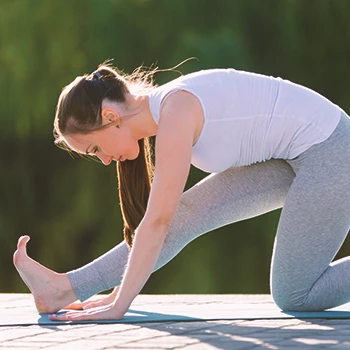
How to do this position:
- Get in a downward-facing dog position, with your hands and feet on the mat and your hips raised towards the ceiling.
- Transition into a crescent low lunge pose by stepping your left foot forward and placing your right knee on the ground.
- Straighten your left leg, ensuring your back knee is positioned directly underneath your hip.
- Place your hands on the mat on either side of your left foot.
- Bend your arms and lean forward, allowing your torso to come closer to your left leg.
- Hold the stretch for fifteen to thirty seconds and repeat on the other leg.
4. Lizard Lunge
How to do this exercise:
- Get on all fours on a yoga mat, with your hands directly under your shoulders and your knees under your hips.
- Transition into a downward-facing dog to stretch your muscles before stepping onto the lizard lunge.
- Step your left leg forward and place your foot on the outer side of your left arm. Keep your right leg straight with the knee lifted off the ground.
- Pace your elbows down onto the mat and interlock your fingers for support.
- Stay in this position for fifteen to thirty seconds, feeling a stretch in your hip flexors and groin muscles.
- Straighten your leg back to the downward-facing dog and repeat the same on the other side.
“As you move through Lizard Pose, go slowly. If you catch yourself holding your breath at any point, pause and refocus.”
- Ann Pizer, Yoga Instructor
5. Low Lunge Quad Stretch
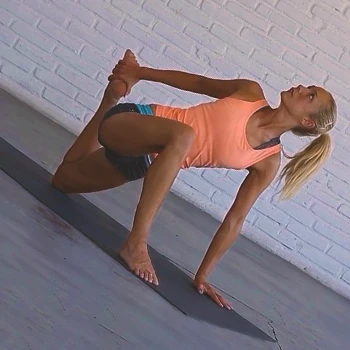
How to perform this exercise:
- Come into a downward-facing dog position.
- Lift your right foot off the mat and extend it towards the ceiling, keeping your toes pointed down.
- Step your right foot between your hands, ensuring your left knee is directly above your left ankle.
- Lower your left knee down to the mat, placing the top of your left foot on the ground.
- Lift your torso and activate your core muscles.
- Sink deeper into the stretch by gently pushing your hips forward until you feel a stretching sensation in your quad.
- Lif your left lower leg and reach back to grab it with your hand.
- Hold for fifteen to thirty seconds and repeat the same on the other side.
Related: Best Quad Stretches
6. Malasana Squat
How to perform this exercise:
- Stand with your feet as wide as a yoga mat's width, and point your toes outwards.
- Lower down into a squat. You can place yoga blocks or any other support beneath your sit bones to provide stability and assistance.
- Place your hand in a prayer position and bring the elbows to the inner thighs to help drive your legs a little wider. Keep your chest lifted.
- Hold for fifteen to thirty seconds.
7. Pigeon Pose
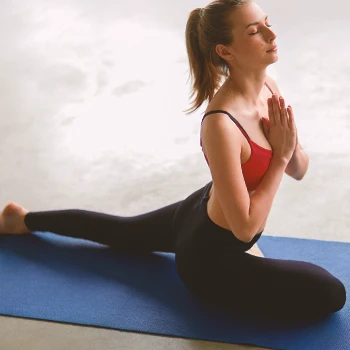
How to do this exercise:
- Get on a downward-facing dog position.
- Raise one leg towards the ceiling.
- Bring the raised leg down and position the knee between your wrists.
- Walk your back leg, straightening it and pressing the foot into the mat.
- Raise your chest and place your fingertips by your sides on the floor for balance.
- Hold this position while taking a few breaths.
- If comfortable, you can deepen the stretch by resting your forehead on the floor and placing your hands by the sides of your head.
- Hold for fifteen seconds and repeat on the other side.
8. Standing Hamstring Stretch
How to do the standing hamstring stretch:
- Stand in front of a chair.
- Place your right foot on the chair, with your toes pointing upward and your heel resting securely on the seat.
- Slowly bend forward from your hips, reaching towards the toes, maintaining a straight back and extending your right leg.
- Reach towards your toes with your hands, aiming to feel a gentle stretch in your hamstring.
- Hold for ten to fifteen seconds and repeat on the other side.
9. Butterfly Pose
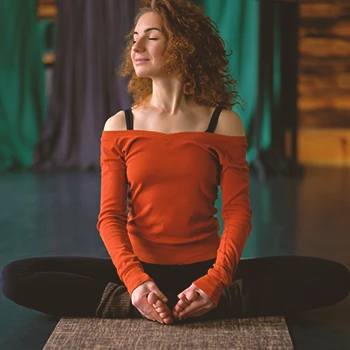
How to do this exercise:
- Sit on the floor, ensuring your spine is aligned, and your shoulders are relaxed.
- Bring the soles of your feet together.
- Interlock your fingers and place them onto your toes.
- Begin to flap your thighs up and down gently.
- Hold for fifteen to thirty seconds.
“Do not hold your breath while stretching. As yoga teaches, the breath can help you stretch deeper. Inhale as you rest and exhale as you initially do the work.”
- Elizabeth Quinn, Exercise Physiologist
10. Frog
How to do this exercise:
- Get on all fours.
- Take your knees as wide as possible.
- Point your toes outwards and open your feet wider than your knees.
- Drive the hips back towards your heels while lowering your upper body onto your forearms.
- Hold for fifteen to thirty seconds.
Stretching Safety and Tips

A study from ResearchGate indicates that improper execution of stretching poses a potential risk [1].
I recommend following these tips to ensure your safety and maximize the effectiveness of your stretching routine.
- Include a rest day - Allowing at least one recovery day between sessions is advisable for beginners, similar to any other physical activity.
- Add a warm-up routine - Prioritize a warm-up routine before attempting any intense stretching exercises and when introducing new stretches.
- Stay with your breath - Focus on staying connected to your breath as you hold the stretch.
- Hold for at least 15 seconds - The American College of Sports Medicine (ACSM) recommends static stretching, following an active warm-up, at least two days per week. Each stretch should be held for fifteen to thirty seconds and repeated two to four times [2].
- Engage your core muscle - Prioritize engaging your core muscles during stretching by consciously pulling your belly button towards your spine. This activation protects your back and maintains proper posture throughout the stretching exercise.
- Stop if you feel any pain - Discontinue any movement if you experience severe pain to avoid tearing your muscles.
- Include a healthy diet - Choose anti-inflammatory foods to help with flexibility, such as blueberries, fish, turmeric, and watermelon.
What Are the Benefits of Splits?

The benefits of splits are increased range of motion, improved posture, increased blood flow, and reduced stress.
- Increased range of motion - According to the National Institute of Health (NIH), all stretching forms are proven effective in increasing the range of motion [3].
- Improved posture - Stretching can help strengthen the back muscles, leading to improved posture.
- Increased blood flow - According to NIH, stretching is proven to increase blood flow to the muscles and improve circulation [4]. As a result, you can expect improved physical performance, reduced recovery time, and decreased muscle soreness.
- Reduced stress - Research by NIH has shown that introducing a simple stretching program at the workplace may reduce anxiety, bodily pain, and exhaustion while increasing vitality, mental health, and flexibility [5].
Cross-Training for Flexibility
Other forms of exercise like Pilates and martial arts can significantly complement splits training.
- Pilates focuses on core strength, alignment, and flexibility, all of which are crucial for safely achieving splits. It enhances muscular symmetry and balance, reducing the risk of injury during splits training.
- Martial arts, on the other hand, incorporate dynamic movements that improve overall flexibility and range of motion. The high kicks and stretches in martial arts routines naturally extend the muscles needed for splits.
Both disciplines promote body awareness and control, essential for progressing in splits training while ensuring a holistic approach to flexibility and physical fitness.
FAQs
What Should I Target to Train for the Splits?
To train for the splits, you should target your hip flexors, groin, glutes, hamstrings, and quads. It is crucial to focus on strengthening and stretching the hamstrings of your front leg and the hip flexors of your back leg to achieve the front split.
Is it Safe to Stretch Every Day?
It is safe to stretch every day; engaging in light stretching exercises every day is not only safe but also beneficial. However, it is recommended to include at least one recovery day between sessions of deeper stretching.
References:
- https://www.researchgate.net/publication/356911580
- https://books.google.com.tr/books
- https://www.ncbi.nlm.nih.gov/pmc/articles/PMC3273886/
- https://pubmed.ncbi.nlm.nih.gov/29623692/
- https://pubmed.ncbi.nlm.nih.gov/23764394/
About The Author
You May Also Like

